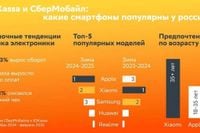On March 21, 2025, a fresh assessment of smartphone preferences revealed a clear leader among Russian consumers. Analysts from YuKassa and SberMobile detailed how Apple has surged ahead of its competitors, overtaking Xiaomi in the ongoing battle for market supremacy. Over the last year, while sales in the electronics segment doubled, the average expenditure on these devices showed a decline.
The report indicates that the top three smartphone brands among Russians are Apple, Xiaomi, and Samsung, in that order. Apple climbed from third to first place, pushing Xiaomi to second and Samsung to third. Huawei and Realme maintained their positions at fourth and fifth, respectively. Analysts found striking generational preferences in smartphone choices; younger consumers aged 18 to 35 lean towards Apple products, whereas those over 35 show a distinct preference for Xiaomi devices.
The electronics market remains one of the fastest-growing segments, with sales revenue increasing by a staggering 83% year-on-year last winter. Payments within this category have also doubled, demonstrating a robust consumer interest in electronic products despite the economic climate. Interestingly, the average transaction value for electronics declined by 11%, settling at 17,133 rubles. Experts attribute this decrease to ongoing sales events and a noticeable shift towards more budget-friendly options.
Apple's ascendance can be seen not just as a reflection of brand loyalty but potentially also as an indication of shifting consumer values among younger demographics who often seek high-performance and stylish devices. Xiaomi's enduring popularity among older users may suggest a different value set that prioritizes practicality and affordability in smartphone choice.
An intriguing aspect of this report reveals how consumer habits have evolved, particularly in the context of the growth of online shopping platforms like AliExpress. Just recently, AliExpress reported a 10% surge in smartphone demand at the start of 2025, echoing the overall trend of increased consumer spending on electronics.
Analysts assert that the strong growth trajectory in electronics reflects broader economic trends and challenges, with fluctuating purchasing power influencing what consumers are willing to spend on high-end tech. As financial landscapes shift, the market adapts, making way for brands that align with current consumer preferences.
The ongoing shifts in the smartphone market showcase not only a battle of brands but also a reflection of cultural changes among the consumer base in Russia. For instance, the marked preference for Apple among younger users suggests a different outlook on technology and lifestyle.
Overall, the ranking remains stable in terms of the brands present, with major players continuing to dominate the preferences of Russian consumers. As this trend continues, it will be interesting to observe how brands adapt their strategies to attract both young and older demographics in a competitive landscape.
This latest data brings to light not just the popularity of certain smartphone brands in Russia but also the underlying consumer behaviors and tendencies that continue to shape the electronics market. With the dynamics between different ages, spending habits, and brand loyalty affecting potential purchases, the future of the smartphone market in Russia looks vibrant yet subject to rapid change.

